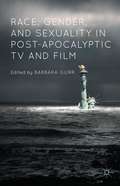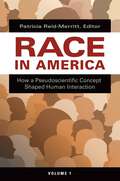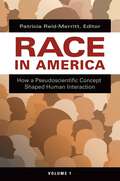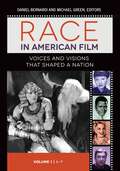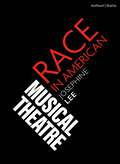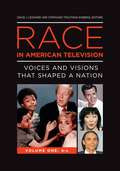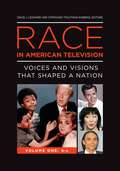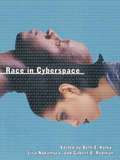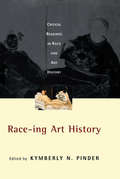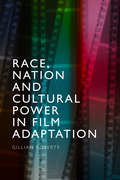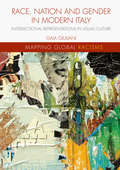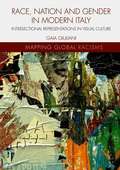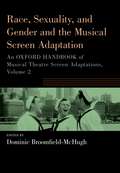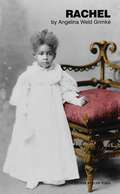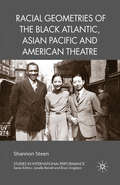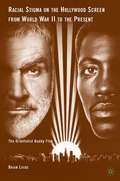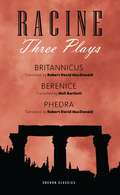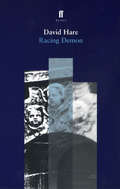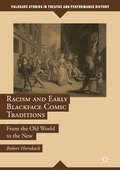- Table View
- List View
Race, Gender, and Sexuality in Post-Apocalyptic TV and Film
by Barbara Gurr Brayton PolkaThis book offers analyses of the roles of race, gender, and sexuality in the post-apocalyptic visions of early twenty-first century film and television shows. Contributors examine the production, reproduction, and re-imagination of some of our most deeply held human ideals through sociological, anthropological, historical, and feminist approaches.
Race in America [2 volumes]: How a Pseudoscientific Concept Shaped Human Interaction [2 volumes]
by Patricia Reid-Merritt, EditorFocusing on the socially explosive concept of race and how it has affected human interactions, this work examines the social and scientific definitions of race, the implementation of racialized policies and practices, the historical and contemporary manifestations of the use of race in shaping social interactions within U.S. society and elsewhere, and where our notions of race will likely lead.More than a decade and a half into the 21st century, the term "race" remains one of the most emotionally charged words in the human language. While race can be defined as "a local geographic or global human population distinguished as a more or less distinct group by genetically transmitted physical characteristics," the concept of race can better be understood as a socially defined construct—a system of human classification that carries tremendous weight, yet is complex, confusing, contradictory, controversial, and imprecise. This collection of essays focuses on the socially explosive concept of race and how it has shaped human interactions across civilization. The contributed work examines the social and scientific definitions of race, the implementation of racialized policies and practices, and the historical and contemporary manifestations of the use of race in shaping social interactions (primarily) in the United States—a nation where the concept of race is further convoluted by the nation's extensive history of miscegenation as well as the continuous flow of immigrant groups from countries whose definitions of race, ethnicity, and culture remain fluid. Readers will gain insights into subjects such as how we as individuals define ourselves through concepts of race, how race affects social privilege, "color blindness" as an obstacle to social change, legal perspectives on race, racialization of the religious experience, and how the media perpetuates racial stereotypes.
Race in America [2 volumes]: How a Pseudoscientific Concept Shaped Human Interaction [2 volumes]
Focusing on the socially explosive concept of race and how it has affected human interactions, this work examines the social and scientific definitions of race, the implementation of racialized policies and practices, the historical and contemporary manifestations of the use of race in shaping social interactions within U.S. society and elsewhere, and where our notions of race will likely lead.More than a decade and a half into the 21st century, the term "race" remains one of the most emotionally charged words in the human language. While race can be defined as "a local geographic or global human population distinguished as a more or less distinct group by genetically transmitted physical characteristics," the concept of race can better be understood as a socially defined construct—a system of human classification that carries tremendous weight, yet is complex, confusing, contradictory, controversial, and imprecise. This collection of essays focuses on the socially explosive concept of race and how it has shaped human interactions across civilization. The contributed work examines the social and scientific definitions of race, the implementation of racialized policies and practices, and the historical and contemporary manifestations of the use of race in shaping social interactions (primarily) in the United States—a nation where the concept of race is further convoluted by the nation's extensive history of miscegenation as well as the continuous flow of immigrant groups from countries whose definitions of race, ethnicity, and culture remain fluid. Readers will gain insights into subjects such as how we as individuals define ourselves through concepts of race, how race affects social privilege, "color blindness" as an obstacle to social change, legal perspectives on race, racialization of the religious experience, and how the media perpetuates racial stereotypes.
Race in American Film [3 volumes]: Voices and Visions That Shaped a Nation [3 volumes]
by Daniel Bernardi and Michael Green, EditorsThis expansive three-volume set investigates racial representation in film, providing an authoritative cross-section of the most racially significant films, actors, directors, and movements in American cinematic history.Hollywood has always reflected current American cultural norms and ideas. As such, film provides a window into attitudes about race and ethnicity over the last century. This comprehensive set provides information on hundreds of films chosen based on scholarly consensus of their importance regarding the subject, examining aspects of race and ethnicity in American film through the historical context, themes, and people involved.This three-volume set highlights the most important films and artists of the era, identifying films, actors, or characterizations that were considered racist, were tremendously popular or hugely influential, attempted to be progressive, or some combination thereof. Readers will not only learn basic information about each subject but also be able to contextualize it culturally, historically, and in terms of its reception to understand what average moviegoers thought about the subject at the time of its popularity—and grasp how the subject is perceived now through the lens of history.
Race in American Film [3 volumes]: Voices and Visions That Shaped a Nation [3 volumes]
This expansive three-volume set investigates racial representation in film, providing an authoritative cross-section of the most racially significant films, actors, directors, and movements in American cinematic history.Hollywood has always reflected current American cultural norms and ideas. As such, film provides a window into attitudes about race and ethnicity over the last century. This comprehensive set provides information on hundreds of films chosen based on scholarly consensus of their importance regarding the subject, examining aspects of race and ethnicity in American film through the historical context, themes, and people involved.This three-volume set highlights the most important films and artists of the era, identifying films, actors, or characterizations that were considered racist, were tremendously popular or hugely influential, attempted to be progressive, or some combination thereof. Readers will not only learn basic information about each subject but also be able to contextualize it culturally, historically, and in terms of its reception to understand what average moviegoers thought about the subject at the time of its popularity—and grasp how the subject is perceived now through the lens of history.
Race in American Musical Theater (Topics in Musical Theatre)
by Josephine LeeWhile most discussions of race in American theater emphasize the representation of race mainly in terms of character, plot, and action, Race in American Musical Theater highlights elements of theatrical production and reception that are particular to musical theater. Examining how race functions through the recurrence of particular racial stereotypes and storylines, this introductory volume also looks at casting practices, the history of the chorus line, and the popularity of recent shows such as Hamilton. Moving from key examples such as Show Boat! and South Pacific through to all-Black musicals such as Dreamgirls, Bring in 'da Noise, Bring in 'da Funk, and Jelly's Last Jam, this concise study serves as a critical survey of how race is presented in the American musical theater canon.Providing readers with historical background, a range of case studies and models of critical analysis, this foundational book prompts questions from how stereotypes persist to “who tells your story?”
Race in American Musical Theater (Topics in Musical Theatre)
by Josephine LeeWhile most discussions of race in American theater emphasize the representation of race mainly in terms of character, plot, and action, Race in American Musical Theater highlights elements of theatrical production and reception that are particular to musical theater. Examining how race functions through the recurrence of particular racial stereotypes and storylines, this introductory volume also looks at casting practices, the history of the chorus line, and the popularity of recent shows such as Hamilton. Moving from key examples such as Show Boat! and South Pacific through to all-Black musicals such as Dreamgirls, Bring in 'da Noise, Bring in 'da Funk, and Jelly's Last Jam, this concise study serves as a critical survey of how race is presented in the American musical theater canon.Providing readers with historical background, a range of case studies and models of critical analysis, this foundational book prompts questions from how stereotypes persist to “who tells your story?”
Race in American Television [2 volumes]: Voices and Visions That Shaped a Nation [2 volumes]
by David J. Leonard and Stephanie Troutman RobbinsThis two-volume encyclopedia explores representations of people of color in American television. It includes overview essays on early, classic, and contemporary television and the challenges for, developments related to, and participation of minorities on and behind the screen.Covering five decades, this encyclopedia highlights how race has shaped television and how television has shaped society. Offering critical analysis of moments and themes throughout television history, Race in American Television shines a spotlight on key artists of color, prominent shows, and the debates that have defined television since the civil rights movement. This book also examines the ways in which television has been a site for both reproduction of stereotypes and resistance to them, providing a basis for discussion about racial issues in the United States.This set provides a significant resource for students and fans of television alike, not only educating but also empowering readers with the necessary tools to consume and watch the small screen and explore its impact on the evolution of racial and ethnic stereotypes in U.S. culture and beyond. Understanding the history of American television contributes to deeper knowledge and potentially helps us to better apprehend the plethora of diverse shows and programs on Netflix, Hulu, YouTube, and other platforms today.
Race in American Television [2 volumes]: Voices and Visions That Shaped a Nation [2 volumes]
This two-volume encyclopedia explores representations of people of color in American television. It includes overview essays on early, classic, and contemporary television and the challenges for, developments related to, and participation of minorities on and behind the screen.Covering five decades, this encyclopedia highlights how race has shaped television and how television has shaped society. Offering critical analysis of moments and themes throughout television history, Race in American Television shines a spotlight on key artists of color, prominent shows, and the debates that have defined television since the civil rights movement. This book also examines the ways in which television has been a site for both reproduction of stereotypes and resistance to them, providing a basis for discussion about racial issues in the United States.This set provides a significant resource for students and fans of television alike, not only educating but also empowering readers with the necessary tools to consume and watch the small screen and explore its impact on the evolution of racial and ethnic stereotypes in U.S. culture and beyond. Understanding the history of American television contributes to deeper knowledge and potentially helps us to better apprehend the plethora of diverse shows and programs on Netflix, Hulu, YouTube, and other platforms today.
Race in Cyberspace
by Beth E. Kolko Lisa Nakamura Gisbert B. RodmanGroundbreaking and timely, Race in Cyberspace brings to light the important yet vastly overlooked intersection of race and cyberspace.
Race in Cyberspace
by Beth Kolko Lisa Nakamura Gilbert RodmanGroundbreaking and timely, Race in Cyberspace brings to light the important yet vastly overlooked intersection of race and cyberspace.
Race-ing Art History: Critical Readings in Race and Art History
by Kymberly N. PinderFirst Published in 2002. Routledge is an imprint of Taylor & Francis, an informa company.
Race-ing Art History: Critical Readings in Race and Art History
by Kymberly N. PinderFirst Published in 2002. Routledge is an imprint of Taylor & Francis, an informa company.
Race, Nation and Cultural Power in Film Adaptation
by Gillian RobertsExamines race and nation in postcolonial, settler-colonial, and Indigenous film adaptation Advances adaptation studies by offering a nuanced critique of the injunction against fidelity criticism 16 case studies of film adaptations across 7 chapters, detailing different modes of postcolonial, settler-colonial, and Indigenous film adaptation Wide-ranging comparative study, including literary and cinematic texts from Aotearoa/New Zealand, Australia, Canada, India, the UK, and the US In Race, Nation and Cultural Power in Film Adaptation, Roberts undertakes the first full-length study of postcolonial, settler-colonial and Indigenous film adaptation, encompassing literary and cinematic texts from Australian, Canadian, New Zealand, Indian, British, and US cultures. A necessary rethinking of adaptation in the context of race and nation, this book interrogates adaptation studies’ rejection of ‘fidelity criticism’ to consider the ethics and aesthetics of translating narratives from literature to cinema and across national borders for circulation in the global cultural marketplace. In this way, Roberts also traces the circulation of cultural power through these adaptations as they move into new contexts and find new audiences, often at a considerable geographical remove from the production of the source material. Further, this book assesses the impact of national and transnational industrial contexts of cultural production on the film adaptations themselves.
Race, Nation and Cultural Power in Film Adaptation
by Gillian RobertsExamines race and nation in postcolonial, settler-colonial, and Indigenous film adaptation Advances adaptation studies by offering a nuanced critique of the injunction against fidelity criticism 16 case studies of film adaptations across 7 chapters, detailing different modes of postcolonial, settler-colonial, and Indigenous film adaptation Wide-ranging comparative study, including literary and cinematic texts from Aotearoa/New Zealand, Australia, Canada, India, the UK, and the US In Race, Nation and Cultural Power in Film Adaptation, Roberts undertakes the first full-length study of postcolonial, settler-colonial and Indigenous film adaptation, encompassing literary and cinematic texts from Australian, Canadian, New Zealand, Indian, British, and US cultures. A necessary rethinking of adaptation in the context of race and nation, this book interrogates adaptation studies’ rejection of ‘fidelity criticism’ to consider the ethics and aesthetics of translating narratives from literature to cinema and across national borders for circulation in the global cultural marketplace. In this way, Roberts also traces the circulation of cultural power through these adaptations as they move into new contexts and find new audiences, often at a considerable geographical remove from the production of the source material. Further, this book assesses the impact of national and transnational industrial contexts of cultural production on the film adaptations themselves.
Race, Nation and Gender in Modern Italy: Intersectional Representations In Visual Culture (Mapping Global Racisms)
by Gaia GiulianiThis book explores intersectional constructions of race and whiteness in modern and contemporary Italy. It contributes to transnational and interdisciplinary reflections on these issues through an analysis of political debates and social practices, focusing in particular on visual materials from the unification of Italy (1861) to the present day. Giuliani draws attention to rearticulations of the transnationally constructed Italian ‘colonial archive’ in Italian racialised identity-politics and cultural racisms across processes of nation building, emigration, colonial expansion, and the construction of the first post-fascist Italian society. The author considers the ‘figures of race’ peopling the Italian colonial archive as composing past and present ideas and representations of (white) Italianness and racialised/gendered Otherness. Students and scholars across a range of disciplines, including Italian studies, political philosophy, sociology, history, visual and cultural studies, race and whiteness studies and gender studies, will find this book of interest.
Race, Nation and Gender in Modern Italy (pdf)
by Gaia GiulianiThis book explores intersectional constructions of race and whiteness in modern and contemporary Italy. It contributes to transnational and interdisciplinary reflections on these issues through an analysis of political debates and social practices, focusing in particular on visual materials from the unification of Italy (1861) to the present day. Giuliani draws attention to rearticulations of the transnationally constructed Italian ‘colonial archive’ in Italian racialised identity-politics and cultural racisms across processes of nation building, emigration, colonial expansion, and the construction of the first post-fascist Italian society. The author considers the ‘figures of race’ peopling the Italian colonial archive as composing past and present ideas and representations of (white) Italianness and racialised/gendered Otherness. Students and scholars across a range of disciplines, including Italian studies, political philosophy, sociology, history, visual and cultural studies, race and whiteness studies and gender studies, will find this book of interest.
Race, Sexuality, and Gender and the Musical Screen Adaptation: An Oxford Handbook of Musical Theatre Screen Adaptations, Volume 2 (OXFORD HANDBOOKS SERIES)
by Dominic Broomfield-McHughHollywood's conversion to sound in the 1920s created an early peak in the film musical, following the immense success of The Jazz Singer. The opportunity to synchronize moving pictures with a soundtrack suited the musical in particular, since the heightened experience of song and dance drew attention to the novelty of the technological development. Until the near-collapse of the genre in the 1960s, the film musical enjoyed around thirty years of development, as landmarks such as The Wizard of Oz, Meet Me in St. Louis, Singin' in the Rain, and Gigi showed the exciting possibilities of putting musicals on the silver screen. The second of three volumes, Race, Sexuality, and Gender and the Musical Screen Adaptation: An Oxford Handbook, traces how the genre of the stage-to-screen musical has evolved, focusing in particular of issues of race, gender and sexuality. Enduringly popular adaptations such as Kiss Me Kate and Pal Joey are considered through the lens of identity, while several chapters consider how different adaptations of the same stage musical reflect shifting historical contexts. Together, the chapters incite lively debates about the process of adapting Broadway for the big screen and provide models for future studies. Volume I: The Politics of the Musical Theatre Screen Adaptation Volume II: Race, Sexuality, and Gender and the Musical Screen Adaptation Volume III: Stars, Studios, and the Musical Theatre Screen Adaptation
Race, Sexuality, and Gender and the Musical Screen Adaptation: An Oxford Handbook of Musical Theatre Screen Adaptations, Volume 2 (OXFORD HANDBOOKS SERIES)
Hollywood's conversion to sound in the 1920s created an early peak in the film musical, following the immense success of The Jazz Singer. The opportunity to synchronize moving pictures with a soundtrack suited the musical in particular, since the heightened experience of song and dance drew attention to the novelty of the technological development. Until the near-collapse of the genre in the 1960s, the film musical enjoyed around thirty years of development, as landmarks such as The Wizard of Oz, Meet Me in St. Louis, Singin' in the Rain, and Gigi showed the exciting possibilities of putting musicals on the silver screen. The second of three volumes, Race, Sexuality, and Gender and the Musical Screen Adaptation: An Oxford Handbook, traces how the genre of the stage-to-screen musical has evolved, focusing in particular of issues of race, gender and sexuality. Enduringly popular adaptations such as Kiss Me Kate and Pal Joey are considered through the lens of identity, while several chapters consider how different adaptations of the same stage musical reflect shifting historical contexts. Together, the chapters incite lively debates about the process of adapting Broadway for the big screen and provide models for future studies. Volume I: The Politics of the Musical Theatre Screen Adaptation Volume II: Race, Sexuality, and Gender and the Musical Screen Adaptation Volume III: Stars, Studios, and the Musical Theatre Screen Adaptation
Rachel (Oberon Modern Plays)
by Angelina Weld GrimkéToday, we colored men and women, everywhere - are up against it... In the South, they make it as impossible as they can for us to get educated. In the North, they make a pretence of liberality; they give us the ballot and a good education, and then snuff us out. Each year, the problem just to live, gets more difficult to solve.' The first play by an African American woman ever produced professionally. The European premiere – and the world's first production for nearly 100 years – of Rachel is directed by exciting young director Ola Ince, as part of Black History Month. Rachel is a young, educated, middle-class woman. But she is born into an African-American family in the early 20th century – a world in which ignorance and violence prevail. While her family and neighbours find different ways to survive, Rachel's dreams of getting married and becoming a mother collide with the tragic events of her family’s past as she confronts the harsh reality of a racist world. Written exactly midway between the American Civil War and the end of slavery, and the explosion of Civil Rights in the 1960s, this hauntingly beautiful and profoundly shocking play still asks urgent questions for today.
Racial Geometries of the Black Atlantic, Asian Pacific and American Theatre (Studies in International Performance)
by Shannon SteenAn exciting new work on how black and Asian racial structures were woven together within US theatrical practices in the run up to the Second World War, Steen uses this history to model how we might use performance histories to more carefully assess how racial formation occurs on the boundaries between racial groups in an international context.
Racial Stigma on the Hollywood Screen from World War II to the Present: The Orientalist Buddy Film
by Brian LockeRacial Stigma on the Hollywood Screen from WWII to the Present charts how the dominant white and black binary of American racial discourse influences Hollywood s representation of the Asian. The Orientalist buddy film draws a scenario in which two buddies, one white and one black, transcend an initial hatred for one another by joining forces against a foreign Asian menace. Alongside an analysis of multiple genres of film, Brian Locke argues that this triangulated rendering of race ameliorates the longstanding historical contradiction between U.S. democratic ideals and white America s persistent domination over blacks.
Racine: Berenice, Phèdre, Britannicus (Oberon Classics)
by Jean Racine Robert David MacDonald Neil BartlettIncludes the plays Britannicus, Phedra and BereniceJean Racine is the greatest tragedian of the French seventeenth century, using its strict rules and conventions to tell stories of overwhelming passion and cruelty.This volume brings together three of his greatest plays. Britannicus, the earliest, is set in the court of the young Emperor Nero, and in an atmosphere seething with erotic tension, documents the power-struggles surrounding the birth of a legendary despot. Berenice probes the hearts of two lovers as they are torn apart amidst the splendours of Imperial Rome, and in Phedra, the most famous of the three, a woman betrayed by her own desires descends into a personal hell of shame, guilt and remorse. These classic versions, by two of the country's most distinguished director-translators, prove that Racine is far from untranslatable; they offer blisteringly effective poetry, urgent plotting and powerhouse roles for both actors and actresses.
Racing Demon
by David HareHow do you fight without hate?Racing Demon reveals the struggle of four clergymen to make sense of their mission. David Hare's play opened at the National Theatre, London, in 1990 to universal acclaim, and won four awards as Play of the Year. Racing Demon was the first part of David Hare's trilogy of plays about British institutions; Murmuring Judges and The Absence of War completed the trilogy.
Racism and Early Blackface Comic Traditions: From the Old World to the New (Palgrave Studies in Theatre and Performance History)
by Robert HornbackThis book traces blackface types from ancient masks of grinning Africans and phallus-bearing Roman fools through to comedic medieval devils, the pan-European black-masked Titivillus and Harlequin, and racial impersonation via stereotypical 'black speech' explored in the Renaissance by Lope de Vega and Shakespeare. Jim Crow and antebellum minstrelsy recycled Old World blackface stereotypes of irrationality, ignorance, pride, and immorality. Drawing upon biblical interpretations and philosophy, comic types from moral allegory originated supposedly modern racial stereotypes. Early blackface traditions thus spread damning race-belief that black people were less rational, hence less moral and less human. Such notions furthered the global Renaissance’s intertwined Atlantic slave and sugar trades and early nationalist movements. The latter featured overlapping definitions of race and nation, as well as of purity of blood, language, and religion in opposition to 'Strangers'. Ultimately, Old World beliefs still animate supposed 'biological racism' and so-called 'white nationalism' in the age of Trump.
